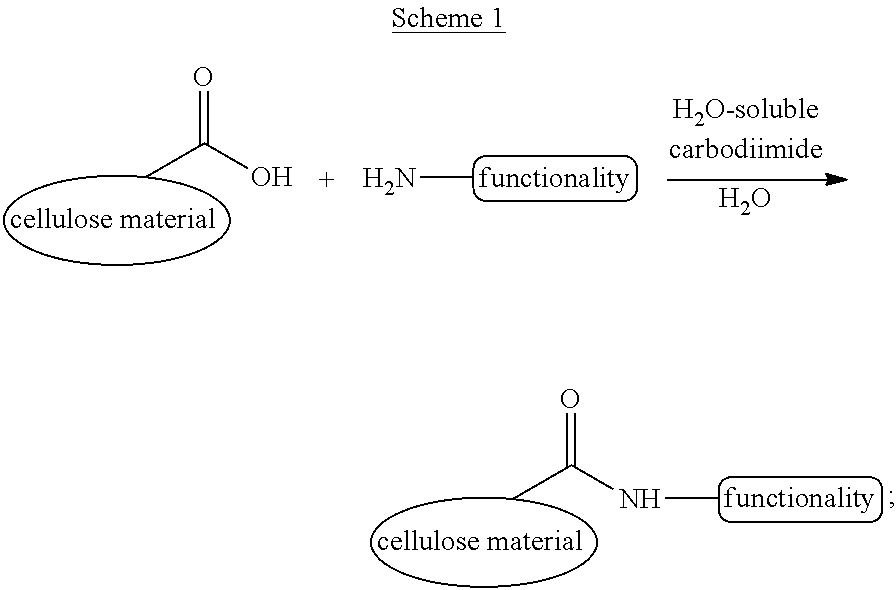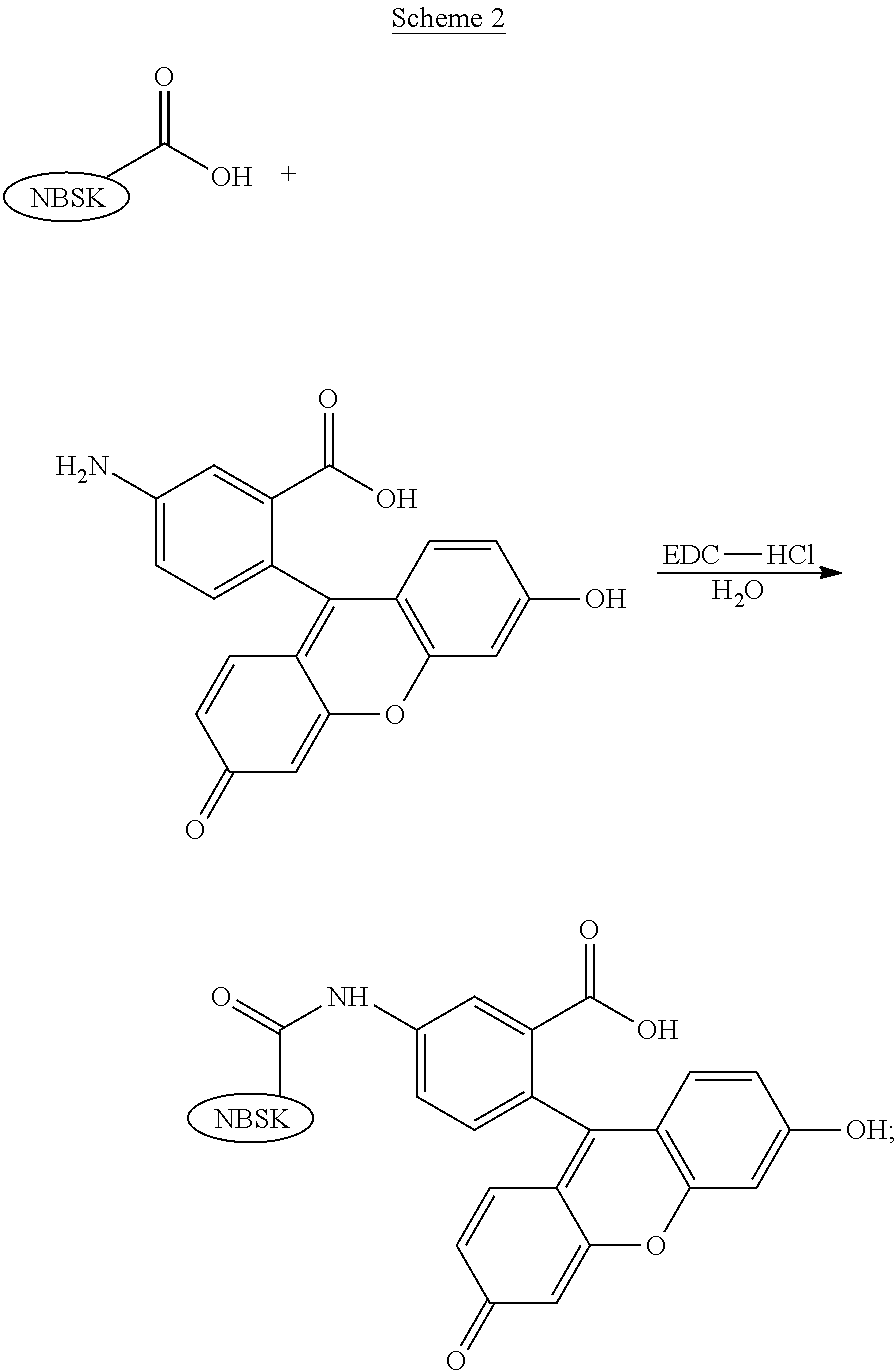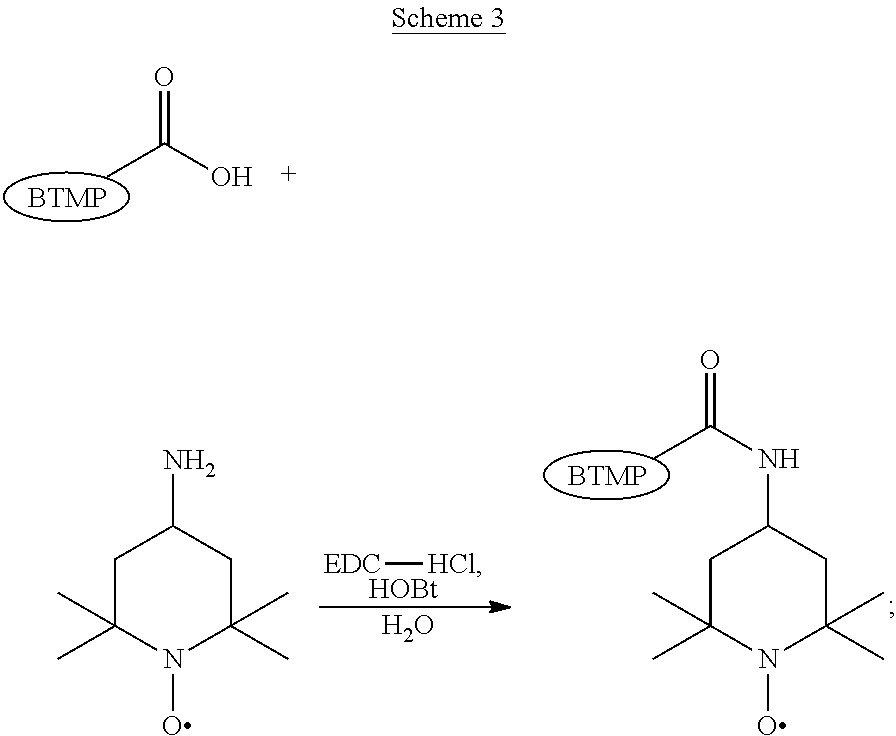Cellulose materials with novel properties
a cellulose and novel technology, applied in the field of cellulosic, lignocellulosic or cellulose materials, can solve the problems of limited iso brightness improvement of pulp and paper such as bctmp and paper containing bctmp
- Summary
- Abstract
- Description
- Claims
- Application Information
AI Technical Summary
Benefits of technology
Problems solved by technology
Method used
Image
Examples
example 1
[0085]A commercial northern bleached softwood kraft (NBSK) pulp (5.0 g od) was reacted with 0.48% (od pulp) of 5-aminofluorescein (“A-fluo”) and 0.50% (od pulp) of EDC.HCl according to the General Procedure A disclosed above except that 0.10% (od pulp) of HOBt was also added. A separate (control) reaction was also performed on 5.0 g (od) of the NBSK pulp according to General Procedure A disclosed above except that 0.0% of EDC.HCl and 0.0% of HOBt were used for the reaction. The amount of “A-fluo” attached to the NBSK was determined to be 0.063% (od pulp), according to General Procedure B disclosed above, for the reaction of the pulp with 0.50% (od pulp) of “A-fluo”, 0.50% (od pulp) of EDC.HCl and 0.10% (od pulp) of HOBt. No “A-fluo” was found to attach to the NBSK pulp, according to General Procedure B disclosed above, for the control reaction of the pulp with 0.50% (od pulp) of “A-fluo”, 0.0% of EDC.HCl and 0.0% of HOBt.
[0086]The NBSK pulp attached with 0.063% (od pulp) of “A-fluo”...
example 2
[0088]A commercial NBSK pulp (5.0 g od) was reacted with 0.49% (od pulp) of “A-fluo” and 0.50% (od pulp) of EDC.HCl according to the General Procedure A disclosed above except that the pH of the pulp slurry was adjusted to 4.0±0.1 under stirring and that the pulp slurry was left at room temperature (˜20° C.) for 2 h. The amount of “A-fluo” attached to the NBSK pulp was determined to be 0.106% (od pulp), according to General Procedure B disclosed above. Scheme 2 is a schematic representation of permanent attachment of 5-aminofluorescein (“A-fluo”) to the NBSK pulp in aqueous media using EDC.HCl as a coupling agent.
example 3
[0089]A commercial NBSK pulp (5.0 g od) was reacted with 0.50% (od pulp) of “A-fluo” and 0.50% (od pulp) of EDC.HCl according to the General Procedure A disclosed above except that the pH of the pulp slurry was adjusted to 4.0±0.1 under stirring and that the pulp slurry was heated at 65° C. for 2 h. The amount of “A-fluo” attached to the NBSK pulp was determined to be 0.058% (od pulp), according to General Procedure B disclosed above.
PUM
| Property | Measurement | Unit |
|---|---|---|
| wavelength | aaaaa | aaaaa |
| wavelength | aaaaa | aaaaa |
| wavelength | aaaaa | aaaaa |
Abstract
Description
Claims
Application Information
 Login to View More
Login to View More - R&D
- Intellectual Property
- Life Sciences
- Materials
- Tech Scout
- Unparalleled Data Quality
- Higher Quality Content
- 60% Fewer Hallucinations
Browse by: Latest US Patents, China's latest patents, Technical Efficacy Thesaurus, Application Domain, Technology Topic, Popular Technical Reports.
© 2025 PatSnap. All rights reserved.Legal|Privacy policy|Modern Slavery Act Transparency Statement|Sitemap|About US| Contact US: help@patsnap.com



